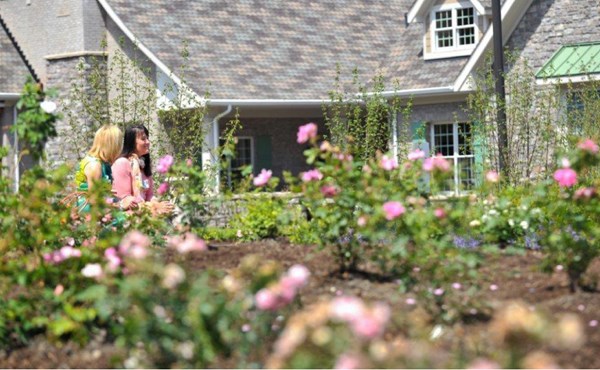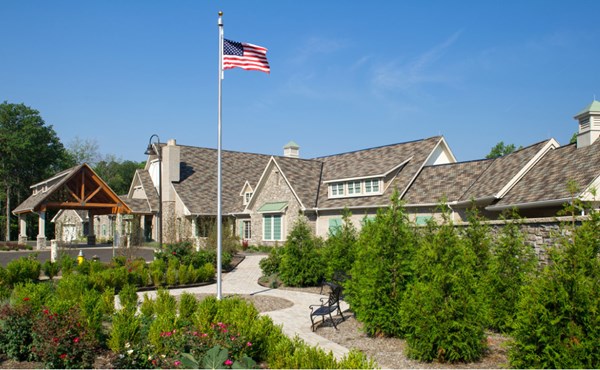CLEVELAND, Dec. 11, 2013 (GLOBE NEWSWIRE) -- Hospice of the Western Reserve announced today that its new 40,000-square foot patient care center, Ames Family Hospice House, has been awarded LEED® Gold certification established by the U.S. Green Building Council and verified by the Green Building Certification Institute (GBCI). LEED is the nation's preeminent program for the design, construction and operation of high performance green buildings.
Ames Family Hospice House achieved LEED Gold certification for energy use, lighting, water and material use as well as incorporating a variety of other sustainable strategies. By using less energy and water, LEED certified buildings save money for families, businesses and taxpayers; reduce greenhouse gas emissions; and contribute to a healthier environment for residents, workers and the larger community. Hospice of the Western Reserve consulted with Hospice Design Resource, PLLC, of Hilton Head, SC, on the project. Vocon Partners, LLC, of Cleveland is the architect of record. Donley's Construction of Cleveland was the general contractor.
Opened in July 2012, Ames Family Hospice House reflects the non-profit agency's commitment to improving human and environmental health. More than 70 percent of the site is green space. The natural creek running through the property was left undisturbed and all of the lawns and gardens are chemical-free. A tree planting program ensures that the wood lot remains diverse and healthy. A rain garden was installed to mitigate storm water runoff. Special parking for eco-friendly vehicles and bike racks encourage the use of alternative transportation.
"We are committed to sustainable organizational practices and environmental stewardship not only at Ames Family Hospice House, but throughout the agency," said Bill Finn, Chief Executive Officer, Hospice of the Western Reserve. "Environmental stewardship, economic vitality and social responsibility are closely aligned with our mission to promote quality of life for our current patients and families, and to leave a positive lasting legacy for future generations."
"Building operations are nearly 40 percent of the solution to the global climate change challenge," said Rick Fedrizzi, President, CEO & Founding Chair, U.S. Green Building Council. "While climate change is a global problem, innovative organizations like Hospice of the Western Reserve are addressing it through local solutions. The Ames Family Hospice House project efficiently uses our natural resources and makes an immediate, positive impact on our planet, which will tremendously benefit future generations to come."
LEED certification of Ames Family Hospice House was based on a number of green design and construction features that positively impact the project itself and the broader community. These features include:
- Only wood certified as sourced from responsible providers was used
- Low VOC paint, carpet and furnishings ensure indoor healthy air quality
- Water-efficient fixtures reduce projected water use by 28 percent
- Interior courtyards and walls of windows bring in ample natural light
- Motion and photosensitive light fixtures respond only when needed
- High-efficiency climate control systems are zoned for the occupants' comfort
- 75 percent of construction debris was diverted by repurposing or recycling
In 2012, the Cuyahoga County Solid Waste Management District provided a grant to Hospice of the Western Reserve for the purchase of recycling containers for Ames Family Hospice House, as well as expert advice on signage and education.
The award of $1,989.66 was used to purchase 39 recycling containers, including internal receptacles for the built-in recycling centers, mixed use material containers for public areas, and mixed use and paper-only containers for staff areas. The grant ensured that recycle containers were in place when the first patient arrived at the facility. Recycling remains an integral part of work processes not only at Ames Family Hospice House, but at all of the non-profit agency's offices and facilities across its six-county service area in Northern Ohio.
Hospice of the Western Reserve
Hospice of the Western Reserve is a nationally acclaimed non-profit agency providing comfort and emotional support to patients and their families. The agency provides palliative end-of-life care, caregiver support and bereavement services throughout the region, and cares for people in a variety of settings, including private residences, assisted living and retirement communities, nursing homes, at Ames Family Hospice House in Westlake and David Simpson Hospice House on Cleveland's east side. For more information, visit hospicewr.org, or call 800.707.8922.
U.S. Green Building Council
The Washington, D.C.-based U.S. Green Building Council is committed to a prosperous and sustainable future for our nation through cost-efficient and energy-saving green buildings. With a community comprising 80 local affiliates, more than 18,000 member companies and organizations, and more than 167,000 LEED Professional Credential holders, USGBC is the driving force of an industry that is projected to contribute $554 billion to the U.S. gross domestic product from 2009-2013. USGBC leads an unlikely diverse constituency of builders and environmentalists, corporations and nonprofit organizations, elected officials and concerned citizens, and teachers and students. Buildings in the United States are responsible for 39% of CO2 emissions, 40% of energy consumption, 13% water consumption and 15% of GDP per year, making green building a source of significant economic and environmental opportunity. Greater building efficiency can meet 85% of future U.S. demand for energy, and a national commitment to green building has the potential to generate 2.5 million American jobs.
LEED
The U.S. Green Building Council's LEED green building certification system is the foremost program for the design, construction and operation of green buildings. Over 100,000 projects are currently participating in the LEED rating systems, comprising over 8 billion square feet of construction space in all 50 states and 114 countries. By using less energy, LEED-certified buildings save money for families, businesses and taxpayers; reduce greenhouse gas emissions; and contribute to a healthier environment for residents, workers and the larger community. USGBC was co-founded by current President and CEO Rick Fedrizzi, who spent 25 years as a Fortune 500 executive. Under his 15-year leadership, the organization has become the preeminent green building, membership, policy, standards, influential, education and research organization in the nation. For more information, visit www.usgbc.org.
Photos accompanying this release are available at:

